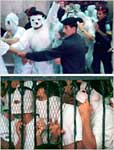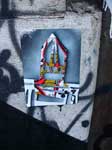NYT:
The eight-part series, which begins on Sunday on Showtime and will be shown on consecutive nights, is smart and suspenseful and teeters just this side of seditious. It doesn’t condone jihad or the hate that fuels it, but it tries to show why they hate us, and in doing so goes further than any other post-9/11 drama on American television.
This season goes further afield. The action in the first season was limited mostly to Los Angeles. This time the plot snakes in and around Los Angeles, London, Hamburg, Sarajevo, back alleys in Sudan, palaces in Saudi Arabia and remote desert base camps in Yemen.
It’s a Tom Clancy cloak-and-dagger tale as told by Graham Greene. Terrorists on “Sleeper Cell” are evil, but the United States is neither innocent nor blameless and carries the seed of its own decline. For every act of barbarity by Muslim radicals, and there are plenty — from nuclear Armageddon to the beheading of a female F.B.I. agent on camera — there is a parallel, if not equivalent, blunder by American law enforcement officials and civilians.
Here.






























